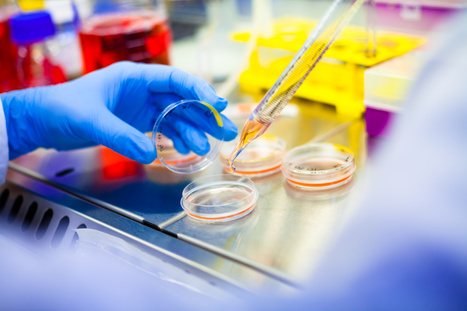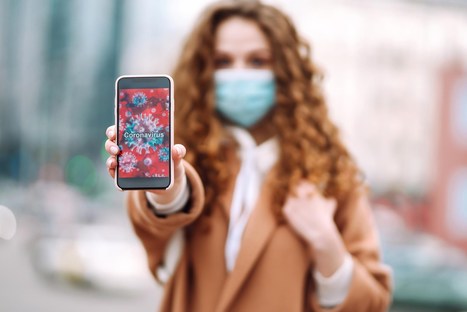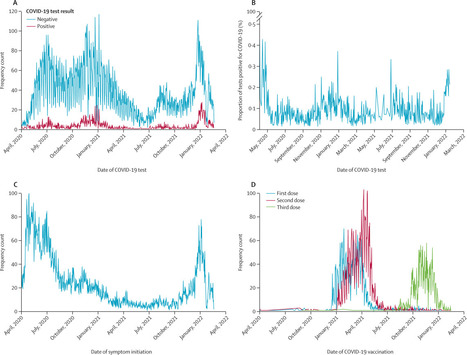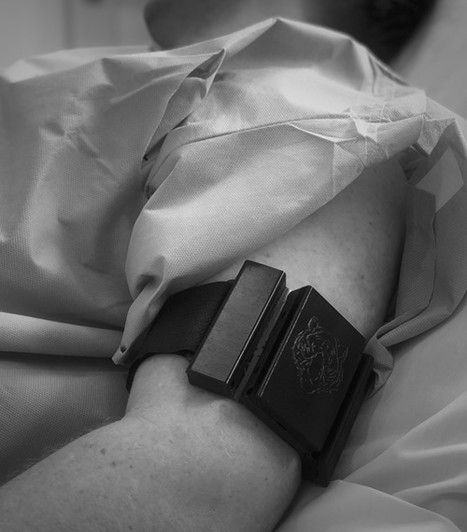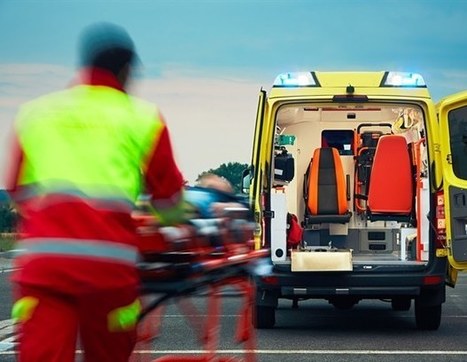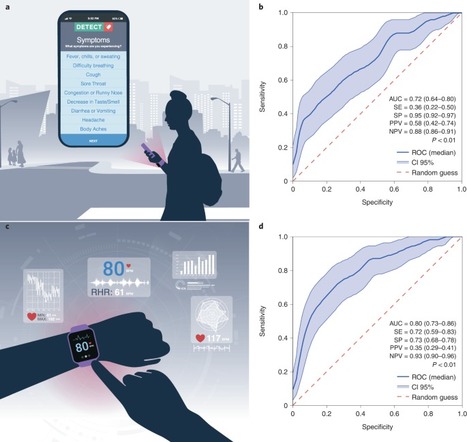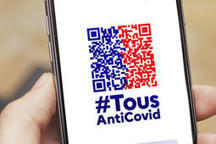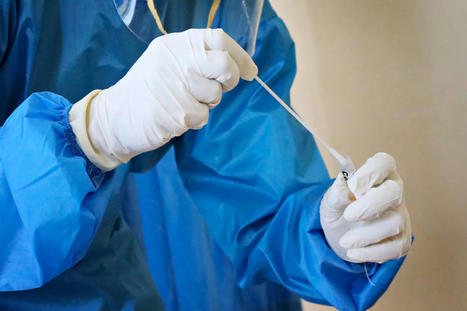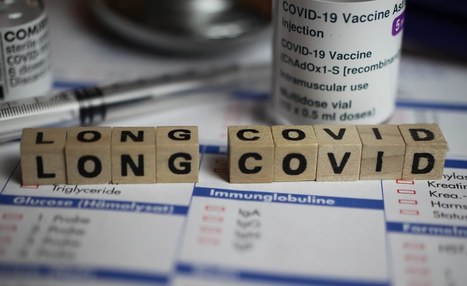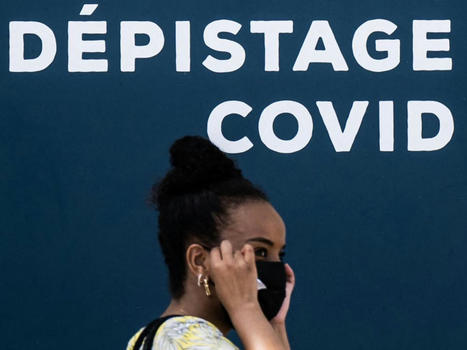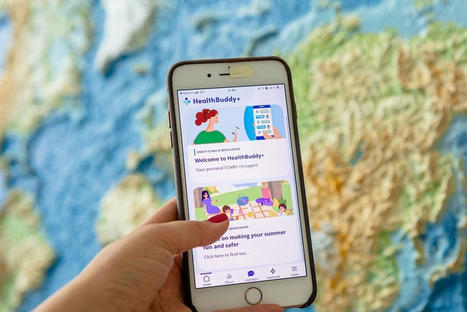 Your new post is loading...
 Your new post is loading...
La préparation à une pandémie nécessite une « surveillance intelligente » pour contrer les stratégies virales plaide cette équipe de virologues de l’Université d'État de l'Ohio. Ces experts proposent, dans les Actes de l’Académie des Sciences américaine, des recommandations, intelligentes, pour améliorer notre réponse mondiale et globale contre de futures épidémies. Lire l'article complet sur : www.santelog.com
Background: Patients with COVID-19 have increased sleep disturbances and decreased sleep quality during and after the infection. The current published literature focuses mainly on qualitative analyses based on surveys and subjective measurements rather than quantitative data.
Objective: In this paper, we assessed the long-term effects of COVID-19 through sleep patterns from continuous signals collected via wearable wristbands.
Methods: Patients with a history of COVID-19 were compared to a control arm of individuals who never had COVID-19. Baseline demographics were collected for each subject. Linear correlations among the mean duration of each sleep phase and the mean daily biometrics were performed. The average duration for each subject’s total sleep time and sleep phases per night was calculated and compared between the 2 groups.
Results: This study includes 122 patients with COVID-19 and 588 controls (N=710). Total sleep time was positively correlated with respiratory rate (RR) and oxygen saturation (SpO2). Increased awake sleep phase was correlated with increased heart rate, decreased RR, heart rate variability (HRV), and SpO2. Increased light sleep time was correlated with increased RR and SpO2 in the group with COVID-19. Deep sleep duration was correlated with decreased heart rate as well as increased RR and SpO2. When comparing different sleep phases, patients with long COVID-19 had decreased light sleep (244, SD 67 vs 258, SD 67; P=.003) and decreased deep sleep time (123, SD 66 vs 128, SD 58; P=.02).
Conclusions: Regardless of the demographic background and symptom levels, patients with a history of COVID-19 infection demonstrated altered sleep architecture when compared to matched controls. The sleep of patients with COVID-19 was characterized by decreased total sleep and deep sleep.
Lire l'article complet sur : www.jmir.org
Pharma giant Pfizer has shelled out nearly US$120 million to acquire a small Australian company claiming to have developed a smartphone app that can accurately diagnose COVID-19 by analyzing the sound of a cough. Lire l'article complet sur : newatlas.com
Introduction: There is emerging literature on the decline in adherence to preventive measures against the COVID-19 pandemic, a phenomenon of pandemic fatigue (PF). However, academics and policymakers have debated its existence and consequences. We conducted this study to explore this phenomenon, its existence, determinants, and relation to adherence to COVID-19 preventive measures, and the mediating role of resilience, fear of COVID-19, and electronic health literacy about COVID-19 in this relationship.
Methods: This cross-sectional online study was conducted from April to June 2021 using a convenience sample of 650 Saudi adults from all regions of Saudi Arabia using a reliable questionnaire. A structural equation model (SEM) was used for mediation analysis.
Results: The results revealed a moderate level of PF among Saudi adults. Younger patients experienced more PF. Fear of COVID-19 had a non-significant (p=0.127) effect on PF. SEM analysis revealed that both resilience and electronic health literacy significantly (p=0.000) mediated the relationship between PF and adherence to preventive measures, and acted as protective factors. In conclusion, there is evidence that PF exists and negatively affects adherence to preventive measures.
Conclusion: Policymakers should apply evidence-based programs to increase public resilience, particularly targeting young adults, as the results of the current study shed light on its protective mediating role against PF. Increasing electronic health literacy is an effective strategy for preventing PF through an increase in the perceived effectiveness of preventive measures. Lire l'article complet sur : www.cureus.com
Background: Infection with severe acute respiratory syndrome coronavirus 2 (SARS-CoV-2) induces a prothrombotic state, but long-term effects of COVID-19 on incidence of vascular diseases ar Lire l'article complet sur : www.ahajournals.org
Our study showed that passively collected sensor data from consenting participants
can provide real-time disease tracking and forecasting. With a growing population
of wearable technology users, these sensor data could be integrated into viral surveillance
programmes. Lire l'article complet sur : www.thelancet.com
Incorrect interpretations of health information, which increase during outbreaks and disasters, often negatively impact people’s mental health and increase vaccine hesitancy, and can delay the provision of health care, a new WHO review shows. The authors conclude that the effects of infodemics and health misinformation online can be countered by “developing legal policies, creating and promoting awareness campaigns, improving health-related content in mass media and increasing people’s digital and health literacy”.The systematic review of published studies found 31 reviews that analysed fake news, misinformation, disinformation and infodemics related to health. Misinformation was defined as false or inaccurate information deliberately intended to deceive, while disinformation also included misleading or biased information, manipulated narratives or facts, and propaganda.The authors gathered, compared and summarized this evidence in order to identify ways to address the negative effects of false health information on public health.Understanding the role of social media in spreading misinformation“Twitter, Facebook, YouTube, and Instagram are critical in disseminating the rapid and far-reaching spread of information,” the systematic review explains. The repercussions of misinformation on social media include such negative effects as “an increase in erroneous interpretation of scientific knowledge, opinion polarization, escalating fear and panic or decreased access to health care”. The increased spread of health-related misinformation in a health emergency is accelerated by easy access to online content, especially on smartphones. “During crises such as infectious disease outbreaks and disasters, the overproduction of data from multiple sources, the quality of the information and the speed at which new information is disseminated create social and health-related impacts.”The authors found that social media have been propagating poor-quality health-related information during pandemics, humanitarian crises and health emergencies at an increasing rate. They note, “Such spreading of unreliable evidence on health topics amplifies vaccine hesitancy and promotes unproven treatments.” Countering online misinformation Four studies reviewed in the paper looked at the proportion of health misinformation on social media, and found that it reached up to 51% in posts associated with vaccines, up to 28.8% in posts associated with COVID-19, and up to 60% in posts related to pandemics. Among YouTube videos about emerging infectious diseases, 20–30% were found to contain inaccurate or misleading information.Experts and health professionals are among those best placed to refute misinformation and direct users to information sources that are evidence-based. Countermeasures include awareness campaigns for patients and health-care professionals, platforms with evidence-based data, the inclusion of scientific evidence in health-related content in mass media, and efforts to improve media and health literacy.“Promoting and disseminating trustworthy health information is crucial for governments, health authorities, researchers, and clinicians to outweigh false or misleading health information disseminated in social media,” the paper states. It highlights that social media channels can also be used to counter false or misleading information, but that further studies may be required to evaluate the best format for such outreach and to determine which channels work best for different populations, geographical settings and cultural contexts.Effects of online misinformation on people’s health behaviours The systematic review found that people feel mental, social, political and/or economic distress due to misleading and false health-related content on social media during pandemics, health emergencies and humanitarian crises.However, not all effects of social media have been negative during the COVID-19 pandemic. Eight reviews reported positive outcomes, and some found that several social media platforms generated significantly improved knowledge and awareness, higher compliance with health recommendations, and more positive health-related behaviours among users compared to classic information dissemination models.The paper acknowledges the role of social media in crisis communication and management during health emergencies, but points to the need to counter the production of misinformation on these platforms. Local, national and international efforts are required, as well as additional research. “Future research should investigate the effectiveness and safety of computer-driven corrective and interventional measures against health misinformation, disinformation and fake news and tailor ways to share health-related content on social media platforms without distorted messaging.”The new paper, entitled “Infodemics and health misinformation: a systematic review of reviews”, is published in the Bulletin of the World Health Organization. Lire l'article complet sur : www.who.int
New research shows that two new mobile apps are using various artificial intelligence features to successfully detect and manage diseases such as COVID-19 and COPD. Lire l'article complet sur : healthitanalytics.com
ABSTRACTIntroduction. Increases in C-reactive protein (CRP) are used to track the inflammatory process of COVID-19 and are associated with disease state progres Lire l'article complet sur : academic.oup.com
At the beginning of the COVID-19 pandemic, when false information about the virus began to spread on Twitter, physicians and scientists from Northwestern Medicine and other institutions banded together to combat the deadly misinformation and disinformation and support one another when they ultimately were attacked online for doing so. Lire l'article complet sur : www.news-medical.net
At the beginning of the COVID-19 pandemic, analog tools such as nasopharyngeal swabs for PCR tests were center stage and the major prevention tactics of masking and physical distancing were a throwback to the 1918 influenza pandemic. Overall, there has been scant regard for digital tools, particularly those based on smartphone apps, which is surprising given the ubiquity of smartphones across the globe. Smartphone apps, given accessibility in the time of physical distancing, were widely used for tracking, tracing and educating the public about COVID-19. Despite limitations, such as concerns around data privacy, data security, digital health illiteracy and structural inequities, there is ample evidence that apps are beneficial for understanding outbreak epidemiology, individual screening and contact tracing. While there were successes and failures in each category, outbreak epidemiology and individual screening were substantially enhanced by the reach of smartphone apps and accessory wearables. Continued use of apps within the digital infrastructure promises to provide an important tool for rigorous investigation of outcomes both in the ongoing outbreak and in future epidemics. An overview of apps for outbreak epidemiology, individual screening and contact tracing during the COVID-19 pandemic. Lire l'article complet sur : www.nature.com
Our analyses illustrate the wide spectrum of disease trajectories as shown by differences
in incidence, survival, and clinical pathways. We have provided a modular analytical
framework that can be used to monitor the impact of the pandemic and generate evidence
of clinical and policy relevance using multiple EHR sources. Lire l'article complet sur : www.thelancet.com
La Cnil pointe du doigt l'utilité "marginale" de la fonctionnalité de contact tracing dans l'application TousAntiCovid. Un comble, étant donné qu'il s'agit de son objectif principal : tracer les chaînes de contamination pour les casser. En réalité, l'application est aujourd'hui principalement utilisée pour stocker le pass sanitaire.
Lire l'article complet sur : www.usine-digitale.fr
Via Rémy TESTON
|
medRxiv - The Preprint Server for Health Sciences Lire l'article complet sur : www.medrxiv.org
The COVID-19 pandemic has led more people to start using wearable technology to track vital signs, physical activity, and sleep. The significant features of these devices include their capability to collect continuous, noninvasive data. We developed a COVID-19 risk stratification model using the Biostrap wearable device which utilizes a baseline-adjusted continuous scale and other escalation points-based on our recent case report, to enhance the National Early Warning Score (NEWS2). Preliminary research has found that our adjusted Early Warning Score (Biostrap-EWS) might be highly specific in identifying early-stage respiratory infections. We present the case of Biostrap CEO Sameer Sontakey, a 35-year-old man, whom the app notified as having a high likelihood of respiratory illness after which the diagnosis SARS-CoV-2 was confirmed with a nasal swab. Our Biostrap-EWS algorithm appears to detect respiratory infections in a real-world environment via passively collected biometric data. To validate the reliability of the algorithm, further research is required. Lire l'article complet sur : zenodo.org
Des chercheurs ont mis au point une app qui détecte les maladies respiratoires en analysant la toux du patient. Vers la fin des tests PCR ? Lire l'article complet sur : www.presse-citron.net
Our study showed that passively collected sensor data from consenting participants
can provide real-time disease tracking and forecasting. With a growing population
of wearable technology users, these sensor data could be integrated into viral surveillance
programmes. Lire l'article complet sur : www.thelancet.com
Researchers quantified the features and risk factors of post-acute COVID-19 syndrome or long COVID based on the integration of survey (active) data and passive [mobile health (mHealth) wearable device] data. Lire l'article complet sur : www.news-medical.net
Le Covid-19 a provoqué une crise sanitaire avec des répercussions sur le niveau de vie de chacun, sur les plans de la santé, de l’éduction, le niveau de vie en général et le moral des populations, faisant regresser le monde de cinq ans, selon un rapport. Lire l'article complet sur : www.cnews.fr
Artificial intelligence (AI) can be used to detect COVID-19 infection in people's voices by means of a mobile phone app, according to research to be presented on Monday at the European Respiratory Society International Congress in Barcelona, Spain. Lire l'article complet sur : medicalxpress.com
Des chercheurs viennent d’entraîner une intelligence artificielle à détecter les patients potentiels du Covid long. Lire l'article complet sur : www.24matins.fr
Via Rémy TESTON
Cette IA compare les données médicales d’un patient avant et après qu’il ait eu le covid pour prédire s’il a un Covid long, avec plus de 80% de réussite. Lire l'article complet sur : www.sciencesetavenir.fr
As of June 22, 2022, 3413 cases of monkeypox from 50 countries have been confirmed
by WHO. Accurate and timely predictions on where and how fast monkeypox might spread
are crucial to control the outbreak, and these could be provided by crowdsourced data.
Such data were essential in characterising and predicting the spread of SARS-CoV-2
during the early stages of the pandemic. Given the promise they show for emerging
infectious diseases, have crowdsourced predictions for such diseases come of age? Lire l'article complet sur : www.thelancet.com
“Digital solutions to health risks raised by the COVID-19 infodemic” is a new WHO/Europe policy brief that calls for a whole-of-society approach to improve the public health response to the COVID-19 infodemic and ensure we are better prepared for future health emergencies. In this Q&A, we highlight the main questions that the policy brief addresses and share some of the policy considerations it proposes. 1. What is an infodemic, and why has it been so damaging during the COVID-19 pandemic?An infodemic – or information epidemic – is defined as an overabundance of information, including false or misleading information, in digital and physical environments during an emergency.This has been particularly acute during COVID-19, as false and misleading information has reduced the impact of evidence-based responses that governments and health authorities have made to curb the pandemic. Exposure to false information – both online and offline – has been linked to increased health risks as a result of harmful behaviours, such as using unproven, ineffective treatments, and not adopting recommended protective measures, including vaccination and mask-wearing. The confusion sown by the COVID-19 infodemic has also led to worsened mental health and emotional well-being, and a drop in trust in health-care authorities. 2. What are the main digital solutions that the policy brief identifies, and why are they important in the infodemic response?Social media and the internet have often been used to disseminate overabundant, false and misleading information regarding COVID-19. At the same time, they are key spaces where solutions can be found and implemented. Several digital innovations have been developed to respond to the infodemic, for example:fact-checking and false information reporting and debunking mechanisms; social listening tools (tools to track users’ reactions to pertinent topics on social media platforms) augmented by artificial intelligence (AI);monitoring programmes, multistakeholder coordination initiatives and national regulatory frameworks that respect the principles of freedom of expression; anddigital health literacy interventions to help people recognize misinformation and improve their ability to spot it (also called inoculation). 3. Who should be involved in the infodemic response?Implementing digital solutions to confront the infodemic calls for a whole-of-society approach. This means cooperating with everyone, from the public to social media platforms, the information technology sector, health policy-makers, fact-checking and civil society organizations, and United Nations organizations, among others. The shared objective is to improve the WHO European Region’s public health response to the COVID-19 infodemic and enhance preparedness for future health emergencies. 4. What is WHO doing to address the infodemic in the Region and globally?In response to the infodemic, WHO has launched a variety of initiatives at global and regional levels. In the European Region, these are embedded in the areas of risk communication and community engagement (for example, monitoring for and responding to high-risk infodemic signals through online and offline systems). The initiatives link to digital health (for example, building capacity for electronic learning among national health authorities) as well as behavioural and cultural insights.The brief outlines how WHO/Europe is bringing to life operational and policy considerations in support of and in close coordination with Member States and other subnational and international governmental and nongovernmental stakeholders.Concrete examples of these efforts include the development of digital communication strategies; mobile apps disseminating accurate health information; AI-based innovations for rumour tracking, community feedback and social listening; training, events and conferences to promote infodemic management; social listening and behavioural insights surveys; rumour-tracking mechanisms and multi-language fact-checking; and partnerships with social media and web companies. With this publication, another valuable tool is added to this list. 5. What considerations does WHO/Europe propose to help Member States improve their infodemic responses? The brief proposes a list of policy considerations for all stakeholders, including reinforcing multistakeholder networks for infodemic management; strengthening overall risk communication and community engagement; implementing continuous monitoring of online harmful and false content; improving digital literacy approaches and organizing infodemic management trainings; advocating for infodemic management; and encouraging policy changes to make online platforms safer for users. Lire l'article complet sur : www.who.int
In this issue, Emily Pfaff and colleagues show that machine learning analysis of electronic
health records could be crucial in diagnosing patients with long COVID. This is the
latest in a plethora of studies to use big data to determine prevalence, symptoms,
or risk factors for long COVID. But is big data helping to treat patients with this
heterogeneous condition, or should we be redirecting our efforts elsewhere? Lire l'article complet sur : www.thelancet.com
|



 Your new post is loading...
Your new post is loading...

